Week 10 part 2 - life history trade offs
1/49
There's no tags or description
Looks like no tags are added yet.
Name | Mastery | Learn | Test | Matching | Spaced |
|---|
No study sessions yet.
50 Terms
what is life history
how an organisms allocates its time, energy and resources amongst the following: growth, reproductions, activities relating to survival
fitness trade offs occur bc
every individual has a resrcited amoutn of time, resources and energy at their disposal (this is universal includign humans eg when you wanna have kids)
mating systems (3)
1. promiscuity
2. monogamy
3. polygamy
(polygyny, polyandry, polygynandry)
pomiscuity mating system
both sexes have many mates, no longe term pair bonds eg fish, rodents
monogamy mating system (leads to, parental care, exampel)
1 female males w 1 male for life
leads to: monomorphism (males and females looking alike since not much sexual selection)
parental care: prob shared
eg. trumpeter swans, some birds (used to think all)
polygamy mating system
a member of 1 sex having multiple mates of the other, but not the other way around (e.g., Polygyny: 1 male to many females or Polyandry: 1 female to many males
polygynandry: both males and females have many long term mates)
what does polyandry lead to? polygyny?
reverse dimophism (females organmented)
, sexual dimorphism (males ornameneted)
role of parental care depicting mating system
if young need lots of care: male fitness is maximized by stay and helping female parent
if young do not: male fitness is maximized by looking for more mates
Mating systems in birds
David Lack (1968) - prevailing theory of the 60's
beleived majority of bird were monogomous but they found out through DNA studies that they acc do extra pair copulations
why were birds beleived to be monogomous
- Young birds need lot of xare
- Chicks often born in a helpless condition
- Must learn to fly and need to be fed
- Females dont produce milk so either parent can provide care
- Thought males maxed fitness by sticking around to help
what are extra pair copulations
female birds max their fitness by forming pairbonds then sneaking of and mating with another male aka an extra pair bond
*throw dna they saw many offspring were bonded to non-partener males
By having their nest being a sired by different males they maximize the chance that they will have high genetic quality offspring and having multiple males taking care of the nest
Trick males to provide parental care for offspring that arent even theirs
Eg. zebra finches
the sandhill crane
A truly monogamou bird
Migrate from us to siberia where breeding grounds are
So young must learn the migration route from their parents - need both parents to do so
life history trade offs: what is the trend bw clutch size and probibilty of survival (what does this trade off tell us about maximizing female fitness)
larger clutch size (more offspring) = low survivability of nest/mother CHECK ANSWER
smalller clutch size = higher prob of survival to next year
* explains by female fitness is maximized by keeping male parteber to provide parental care OR ic paternity (extra pair copulation)
Life history traits form a continuum: fecundity and survivorship
*note priority descision of species is unconcious
*you cannot have both high survivorship AND fecundidty
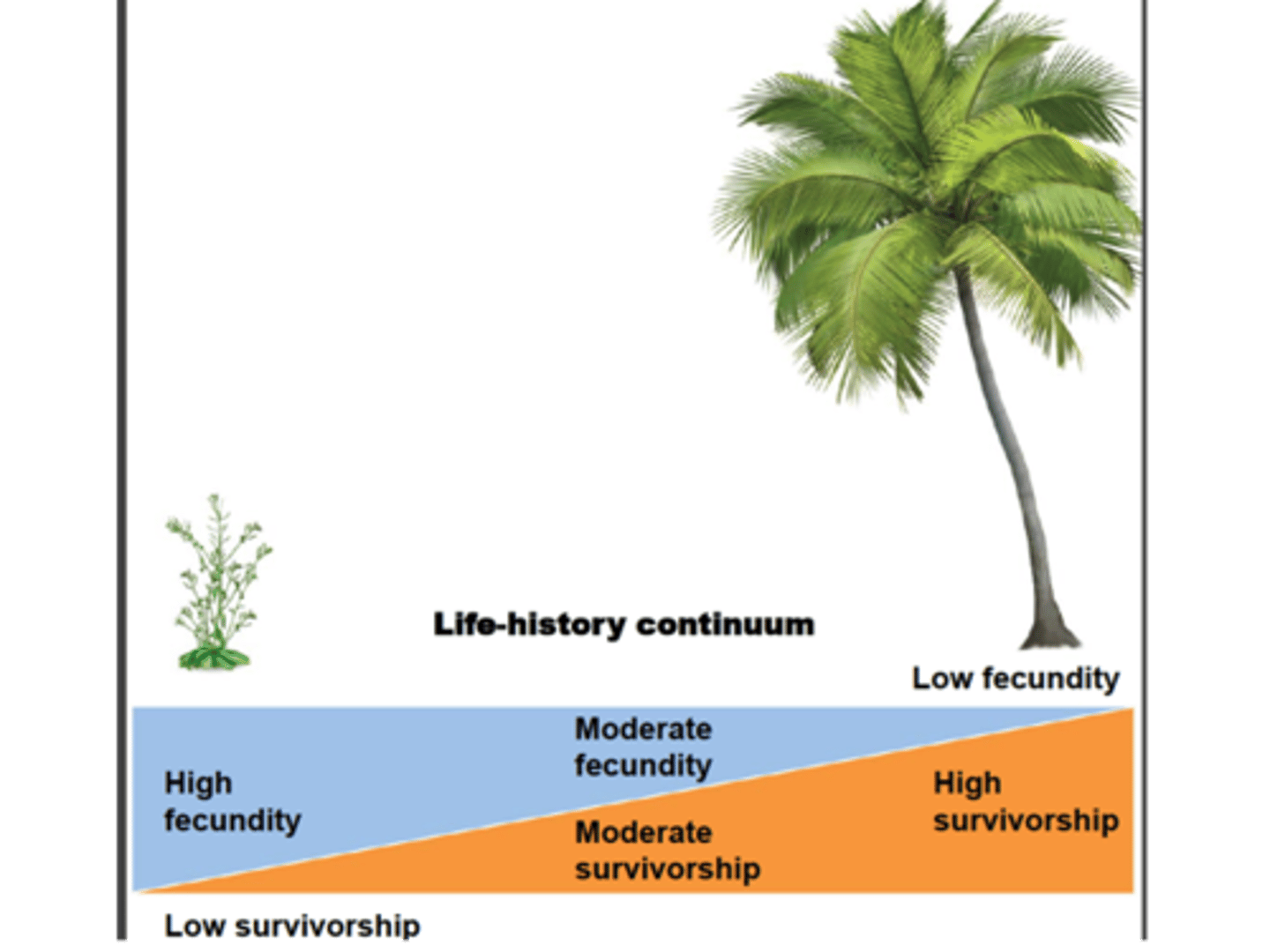
High fecundity = low survivorship of offspring
reach secual maturaty faster to produce many weak seeds/eggs OR many seed w little parental care (frogs)
Low fecundity = high survivorship of offspring
reach sexual maturity later, makes very little amt of offspring and will provide lots of care
eg. acorn given high soruce investment by tree parent
Eg. elephants produce single offspring every decade and rasing it for uyeas
Moderate fecundity and survivorship example
Eg. lizard (from life table) zootoca vivpara fecundity and survivorship depends on temperature in environment
eg warm temp closer to moderate vs
cold environment lizards priotitize survivorship over feunidty
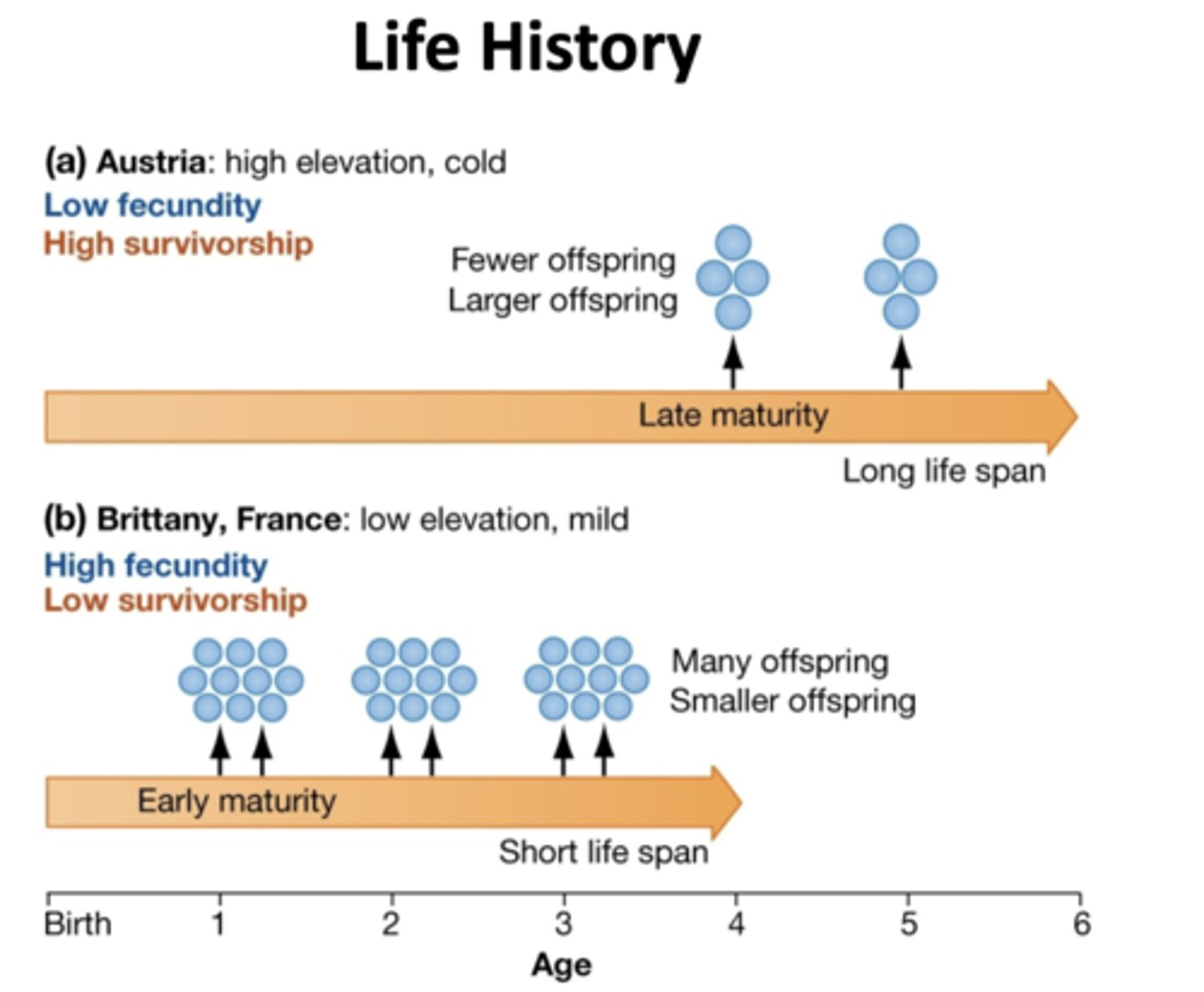
Reproductive Investments (use seeds as exampel)
large no of small seeds = low parental investment eg. cotton wood
small no of large nutrient packed seeds - high parental care eg. acorn form oak trees
trade offs on when to breed
either semelparous
or Iteroparous
Semelparity
a species that reproduces only once during its lifetime and then dies
eg. female octopus grey colour shows high stress signalling shes close to death bc she put her entire octussy into this repoducing even
sempelparity location of fecundity survivorship continuum and their kind of mate choice
high fecundity low survivorship (+ strong mate choice based ong genetic quality rather than behaviour since they get only one shot at it)
Iteroparity (+ effect on mate choice)
Repeated reproduction often in cycles of reproduction
eg. birds
mate choice based on behaviour because they care more about parental care
therfore higher survivor ship lower fecundity
Other trade offs: how much to breed
2 extremes of natural selection:
k selection (density dependent) and r selection (density independent
What is K-selection?
selection for life history traits that are sensitive to saturated evironemtns (N=K) eg. high survivoryship loo fecundity therefore lots of parental care/investment like elephants
because theres a density limit
where to k selected species often take palce
in stable sites
eg. (density dependent) occupy mature/stable forests and invest in competitive ability to survive (suvivorship over fecundity)
what is r-selection?
when selection favours life history traits that favour fecundity over survivorship (i.e. maxmizing repoduction) becuase N<
where do r-selected species take place (what happens when they leave)
short lived /recently disturbed sites - they can do this because they invest alot into reporduction
**in doign this they can actually cahnge these distrubed sites so that k selected species can move in after wars
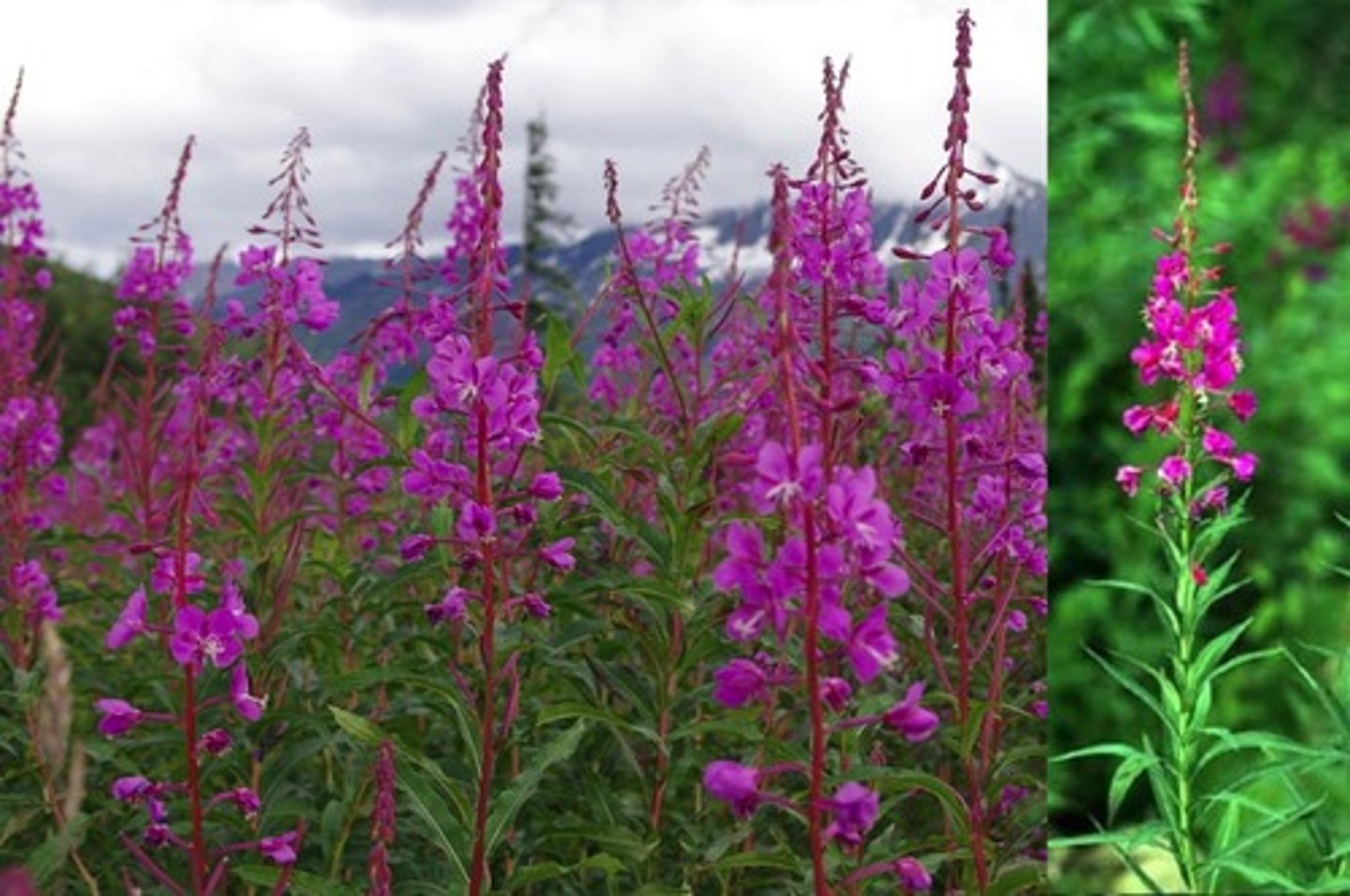
r-selected vs k-selected species: environment type
r: unstable, recently disturbed (∴ must be good dispersers)
k: stable/mature (∴ must be good compeptiors to urviv long)
r-selected vs k-selected species: investment in body size
r: small/low
k: large/high
r-selected vs k-selected species: relative numebvr of offspring
r: HIGH
k: low
r-selected vs k-selected species: maturation pattern
r: reach secual maturity young
k: reach it later
r-selected vs k-selected species: investment in indivudual offspring/parental care
r: low parental care
k: high paretal care
r-selected vs k-selected species: life expectancy (survivor ship curve)
r: short (type 3 curve)
k: long (type 1/2 curve)
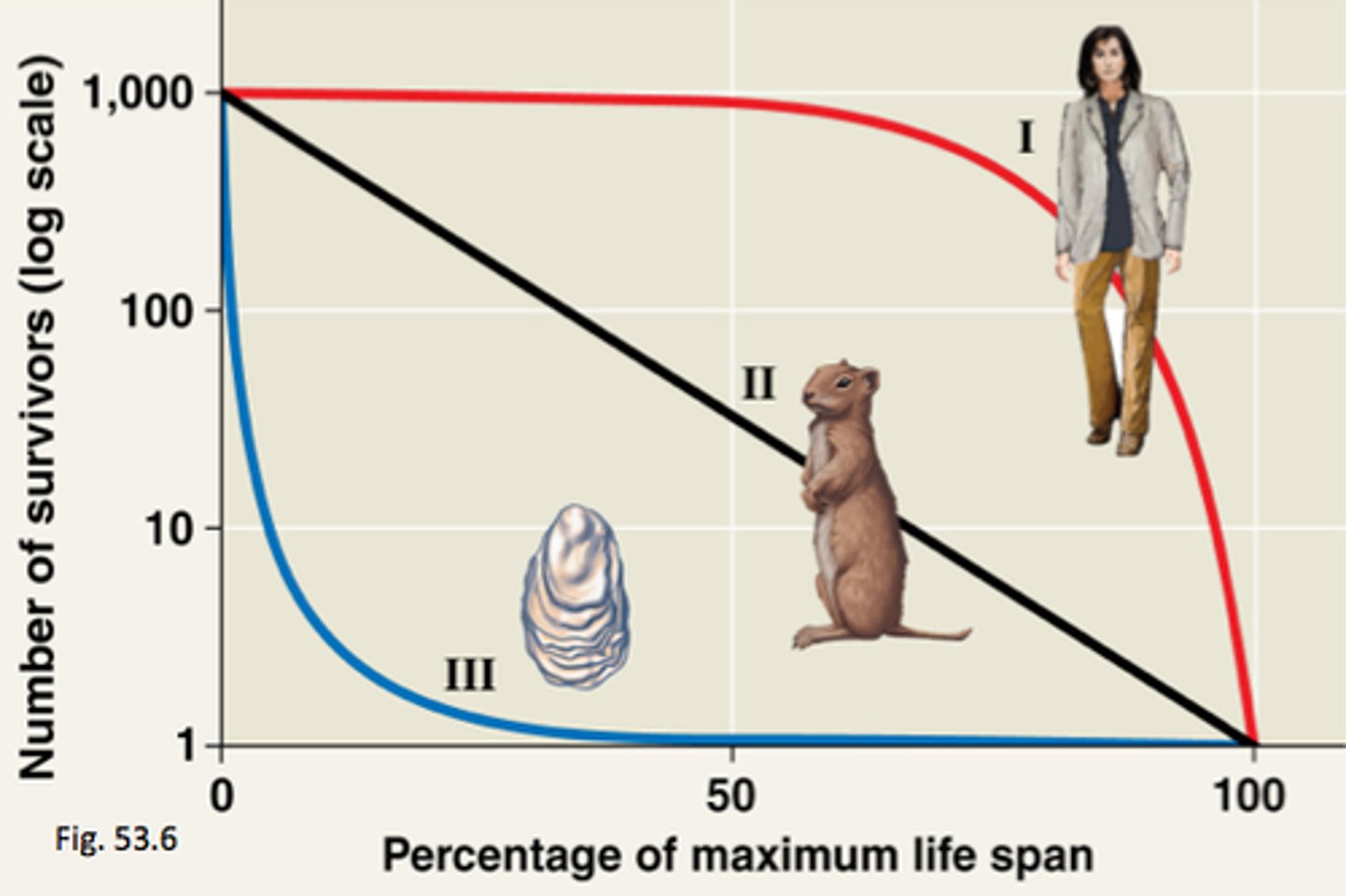
r-selected vs k-selected species: reproductive time life history trade off
r: semelparous (1 big bag reproduction)
k: iteoparous
2 forms of growth of a population
exponentual and logistic growth model
Exponential growth model
density independant growth (for r-selected species) population exponentially increases
*how almost every population starts off
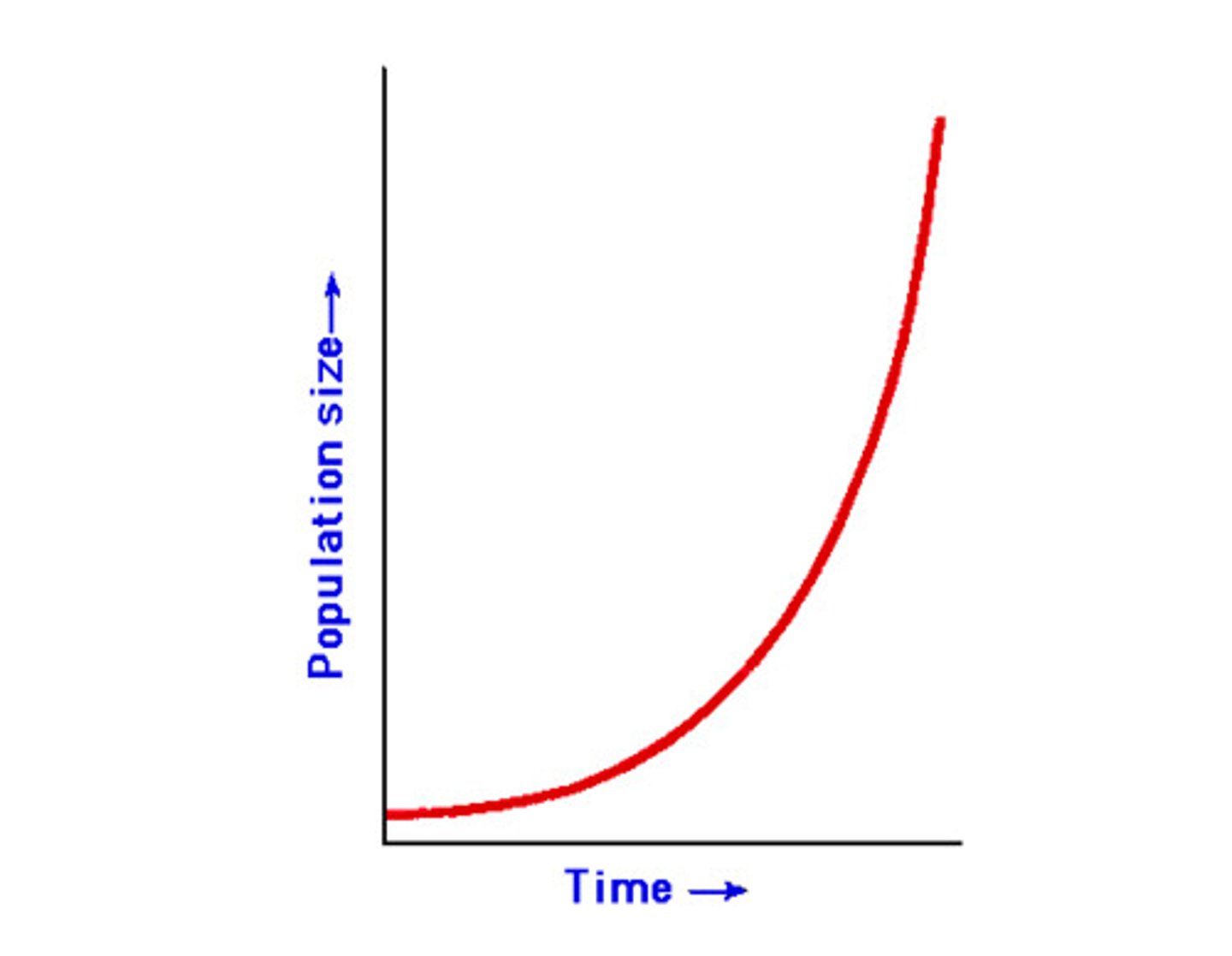
logistic growth model
Gowrth rate (r) begin s to slow down because they hit their carrying capacity (k) keeping population size (N) stable
Sigmoid curve (s-shaped): starts exponential growth then hits inflection point, the point where somehting happens where it cannot continue to grow exponentially switching it from density independent to dependent growth!
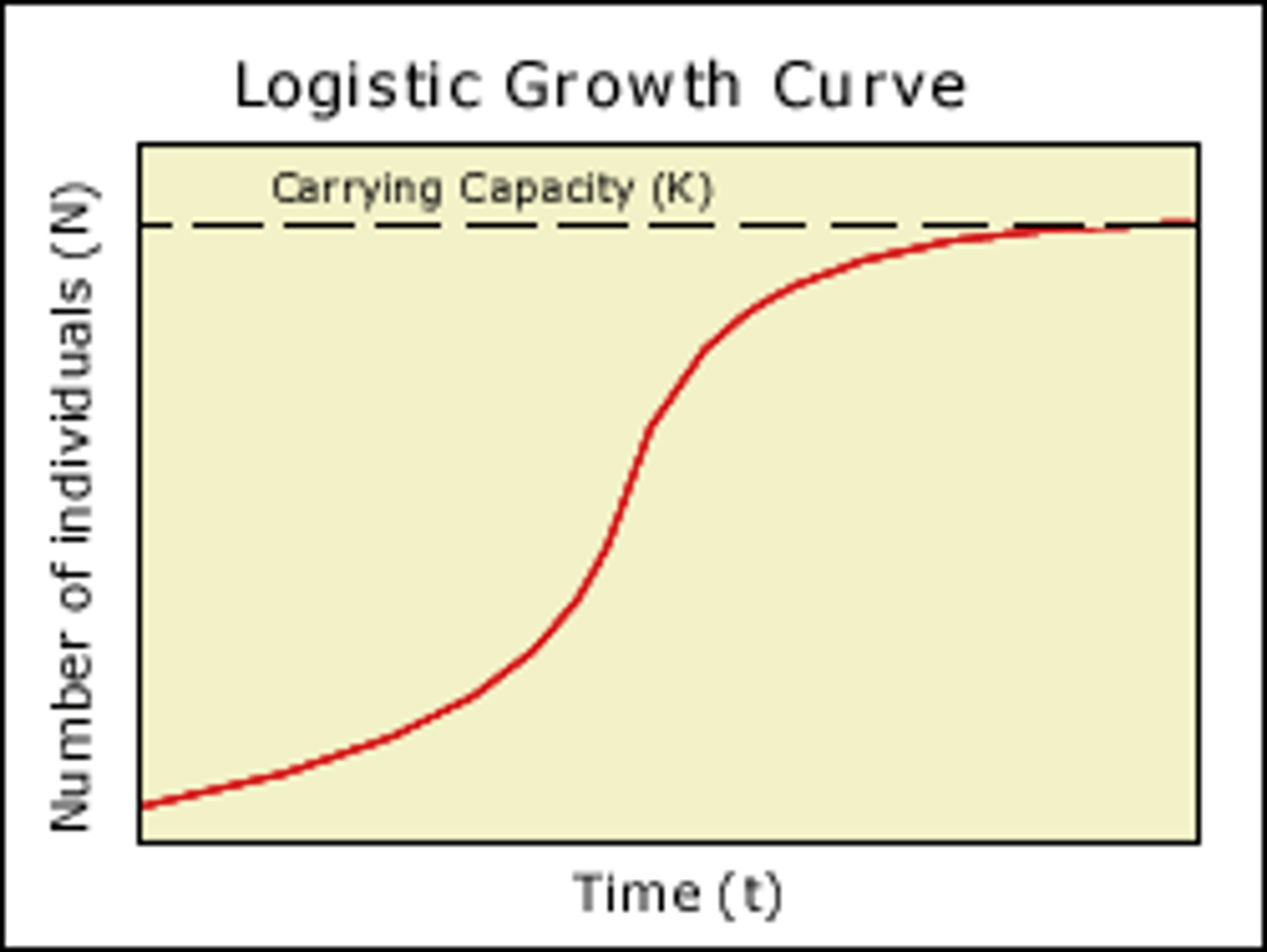
why do population change from exponential to logistical growth
reach carrying capacity ie population runs out of resources. space --> menaing they r now desity dependent and R(growth rate) starts to decline
*species can become k-selected (fevour survivorship ove fecundity)
what is the growth equation with exponential and ligitstic growrth
exponential/ desnity independant:
∆N/∆t (Growth) = rN
logistical/density dependant:
∆N/∆t (growth) = rN x (K - N)/K
*where r is growth rate, n is numebr of individuals, and k is carrying capacity
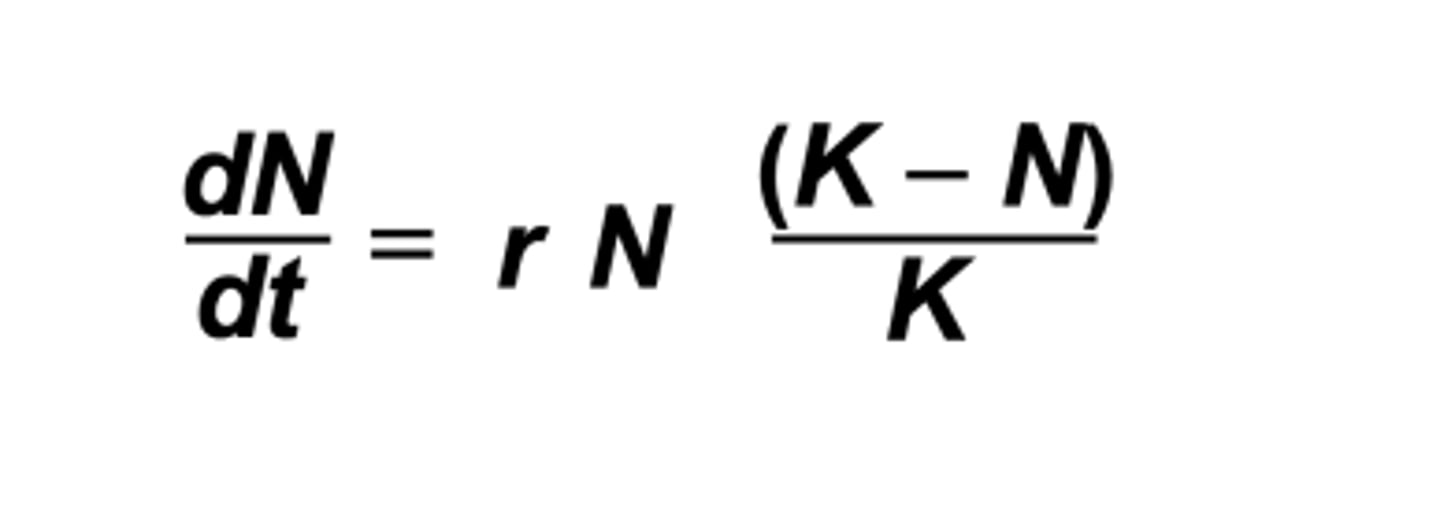
in logistical growth. does the population stop growing?
n0, the rate of growth just gets very very slow once near the K
What do antibiotics do to a patient infected w a logitical growing bacteria?
lowers the bacterias carrying capacity
is carrying capacity always larger than number of individuals in population (K>N?)
theoretically yes, BUT populations (N) can temporarily exceed their carrying capacity (K) sometimes for brief periods of time, and then will come back down to k
- this is because the species doesnt experience th lack of resources until after theyve already reproduced
Exponential growth IRL in natural Populations
natural pops do not exponentially grow indefinetly - only in the very. begining of groeth (eg when first infected)
follows logistic rgowth curve loosley but some can overshoot k before settling down to stable density
can carryin capacity increase if you add more individuals
no will gradually drop back down to carrying capacity you can only inc k by adding mro resources or making environment larger
modifier of growth
a populations growth rate shoudl be porportional to (K-N)/K
ranges from 0-1
When N = K... numerator = 0 therefore only time there is NO GROWTH
When N is high... numerator approaches 0 making the modifier approach 0, low growth
When N is low... numerator approaches 1, making the modifier approach 1, high growth
What Limits Growth Rates and Population Sizes? (2 kinds and examples)
Density-independent factors are usually abiotic eg. wheather, pH, climate (can occur no mater the phase of growth)
density dependent factors are manily biotic eg. inc predation (100 bunny rabits r more likley to catch the eye of a predator than 6) , reduced prey **only occur once population is being limited by its own size
principle: Density -dependent factors --> change survivorship and fecundity --> cause logistic population growth .
Why does growth rate come back to carrying capacity after overshooting?
because fecundity AND durvivorship decrese with high densities (no room to breed, no food left)
what factors can reduce a populations carrying capacity
- new predators moving in
- new competign species moves in
- fewer resources
- habitat loss eg trees getting cut down
- natural disasters, extereme weather, catashtrophes
- infectios
how have humans increases our carrying capacity (inc k to hold mroe N)
Medical innovations: Medicine, Knowdlege of how deases is spread → prevention
vaccinations
Surgery
Inc of food production
- Innovation of pesticides
- Knowledge of agricultural breeding
Eg. drought resistance breeding practicing
Expanding habitats
why is having both k and r selection very important
Eg. r-selected fire weeds
They modicfy ecology of community but altering soil nutrients to restore them
Leave behind more fertile ecology for k-selected species to move in a grow
May be temporary but have lasting impacts